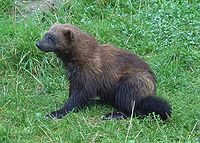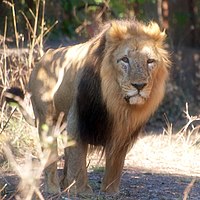
Cicada nymphs dominate American black bear diet in a desert riparian area
Sign Up to like & getrecommendations! Published in 2022 at "Ecology and Evolution"
DOI: 10.1002/ece3.8577
Abstract: Abstract American black bears are considered dependent on high‐elevation forests or other montane habitats in the drylands of western North America. Black bear sign, including that of cubs, was observed throughout the summers of 2015,… read more here.
Keywords: black bears; american black; desert riparian; cicada nymphs ... See more keywords

Evaluating population expansion of black bears using spatial capture‐recapture
Sign Up to like & getrecommendations! Published in 2017 at "Journal of Wildlife Management"
DOI: 10.1002/jwmg.21248
Abstract: The population of American black bears (Ursus americanus) in southern New York, USA has been growing and expanding in range since the 1990s. This has motivated a need to anticipate future patterns of range expansion.… read more here.
Keywords: spatial capture; range; expansion; density ... See more keywords

The effect of sex, age, and location on carnivory in Utah black bears (Ursus americanus)
Sign Up to like & getrecommendations! Published in 2019 at "Oecologia"
DOI: 10.1007/s00442-019-04385-1
Abstract: Ungulates are important to the diet of bears because they are high in protein, and the level of dietary protein strongly influences bear size. The size a bear obtains as an adult influences important life… read more here.
Keywords: carnivory; age; utah black; black bears ... See more keywords

The cascading effects of human food on hibernation and cellular aging in free-ranging black bears
Sign Up to like & getrecommendations! Published in 2019 at "Scientific Reports"
DOI: 10.1038/s41598-019-38937-5
Abstract: Human foods have become a pervasive subsidy in many landscapes, and can dramatically alter wildlife behavior, physiology, and demography. While such subsidies can enhance wildlife condition, they can also result in unintended negative consequences on… read more here.
Keywords: human foods; cellular aging; human food; hibernation ... See more keywords

Wild black bears harbor simple gut microbial communities with little difference between the jejunum and colon
Sign Up to like & getrecommendations! Published in 2020 at "Scientific Reports"
DOI: 10.1038/s41598-020-77282-w
Abstract: The gut microbiome (GMB), comprising the commensal microbial communities located in the gastrointestinal tract, has co-evolved in mammals to perform countless micro-ecosystem services to facilitate physiological functions. Because of the complex inter-relationship between mammals and… read more here.
Keywords: wild black; colon; black bears; jejunum ... See more keywords

American black bears perceive the risks of crossing roads
Sign Up to like & getrecommendations! Published in 2018 at "Behavioral Ecology"
DOI: 10.1093/beheco/ary020
Abstract: When black bears cross roads, their HRs increase, indicating heightened alertness to danger. Wildlife reacts to roads in various ways, but it is unknown whether road crossings are stressful. We monitored black bears with cardiac… read more here.
Keywords: crossing roads; american black; black bears; perceive risks ... See more keywords

Natural rewilding of the Great Basin: Genetic consequences of recolonization by black bears (Ursus americanus)
Sign Up to like & getrecommendations! Published in 2018 at "Diversity and Distributions"
DOI: 10.1111/ddi.12666
Abstract: Aim In the mid-20th century, many populations of large-bodied mammals experienced declines throughout North America. Fortunately, within the last several decades, some have begun to rebound and even recolonize extirpated portions of their native range,… read more here.
Keywords: recolonized areas; recolonization; bears ursus; great basin ... See more keywords

Spring diet of American black bears (Ursus americanus) in a moose (Alces alces) – woodland caribou (Rangifer tarandus caribou) system in northern Ontario, Canada
Sign Up to like & getrecommendations! Published in 2021 at "Canadian Journal of Zoology"
DOI: 10.1139/cjz-2020-0263
Abstract: American black bears (Ursus americanus Pallas, 1780) are opportunistic foragers, and across most of their range in North America, their diet is predominantly vegetation with limited consumption of vertebrates and invertebrates. However, they are also… read more here.
Keywords: bears ursus; moose alces; ursus americanus; american black ... See more keywords

Generalized dermatophytosis caused by Trichophyton equinum in 8 juvenile black bears in California
Sign Up to like & getrecommendations! Published in 2021 at "Journal of Veterinary Diagnostic Investigation"
DOI: 10.1177/10406387211061143
Abstract: From 2014–2019, 8 juvenile black bears (Ursus americanus) from different geographic regions were presented to the California Department of Fish and Wildlife because of emaciation, alopecia, and exfoliative dermatitis that resulted in death or euthanasia.… read more here.
Keywords: dermatophytosis; juvenile black; black bears; generalized dermatophytosis ... See more keywords

Prevalence and genotypic identification of Cryptosporidium spp. and Enterocytozoon bieneusi in captive Asiatic black bears (Ursus thibetanus) in Heilongjiang and Fujian provinces of China
Sign Up to like & getrecommendations! Published in 2020 at "BMC Veterinary Research"
DOI: 10.1186/s12917-020-02292-9
Abstract: Cryptosporidium and Enterocytozoon bieneusi are two important pathogens with zoonotic potential that cause enteric infections in a wide range of hosts, including humans. Both are transmitted from animals to humans by direct contact or through… read more here.
Keywords: bieneusi; heilongjiang fujian; enterocytozoon bieneusi; asiatic black ... See more keywords

High genetic diversity and distinct ancient lineage of Asiatic black bears revealed by non-invasive surveys in the Annapurna Conservation Area, Nepal
Sign Up to like & getrecommendations! Published in 2018 at "PLoS ONE"
DOI: 10.1371/journal.pone.0207662
Abstract: Asiatic black bears (Ursus thibetanus) have a widespread distribution in mountain landscapes, and are considered vulnerable globally, but are low-priority species for conservation in Nepal. Habitat fragmentation, illegal hunting, and human-bear conflict are the major… read more here.
Keywords: genetic diversity; asiatic black; area; conservation ... See more keywords